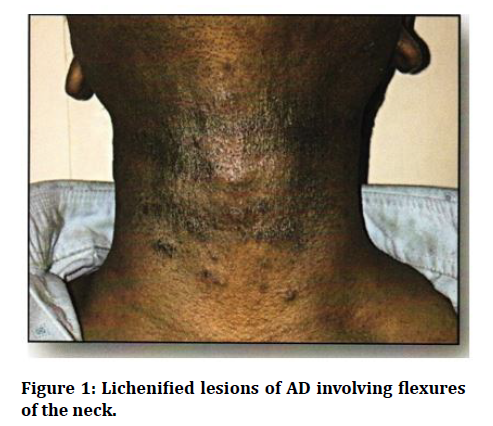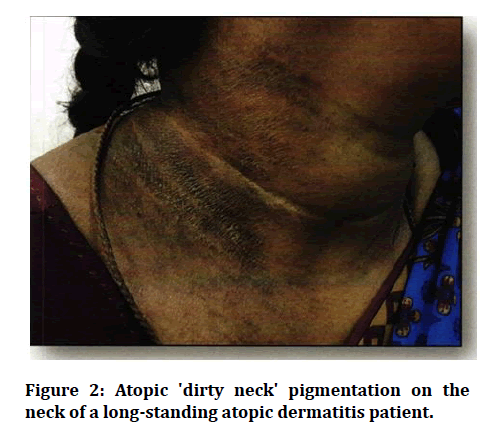Research - (2021) Volume 9, Issue 7
Prevalence of Comorbidities in Atopic Dermatitis
*Correspondence: T Shri Sindhuja, Sree Balaji Medical College & Hospital Affiliated to Bharath Institute of Higher Education and Research, India, Email:
Abstract
High prevalence of comorbidities has been recorded in AD patients compared to normal subjects, hence this study was done. A group of 100 patients above the age of 5 years, diagnosed with AD were examined and investigated for personal or family history of atopy, and co-morbidities like diabetes mellitus, fatty liver, depression, and obesity. In our study, female predominance was noted. It was found that majority number of individuals had a BMI less than 25. History of diabetes was found that 17 out of a total of 100 patients had history of diabetes mellitus, with 12 females and 5 males being affected. Almost 63% had personal history of atopy. we found only 19 % of our study population to have depression. Elevated levels of serum IgG were observed. Only 2 out of a total of I 00 patients had fatty liver.
Keywords
Diabetes mellitus, BMI.Introduction
Atopic dermatitis is one of the threating inflammatory skin diseases. It causes itchy papules; it generally affects the children. It mostly starts with some lesions and progress to erythroderma. Earlier studies have linked presence of these comorbidities in AD patients with poor prognosis, chronic course and recurrence. This study was done to find the prevalence of comorbidities in AD patients m our population, with an aim to add significance to previously done studies [1-4].
Materials and Methods
Study design
Cross-sectional study.
Study area
All Atopic Dermatitis patients attending dermatology OPD, who have clinically been diagnosed to have Atopic Dermatitis.
Inclusion criteria- Patients consenting for the study.
- Patients who have been diagnosed to have atopic dermatitis.
Exclusion criteria
- AD patients <5 years of age.
- Patients not consenting for the study.
- Pregnant or Lactating women.
- Patients with h/o alcohol intake.
- Patients not willing for investigations.
Sample method
Purposive sampling method.
Sample size
100.
Atopic Dermatitis patients attending dermatology OPD were taken for the study. After which a thorough general and dermatological examination were done and measurement of height and weight were ascertained. Followed by Investigating the serum. IgE, FBS, PPBS levels and Ultrasound abdomen was done.
Results
In our study, AD was found to be common in 44% of patients in the age group of: S12years, 20% in the age group of 13-24years, 15% in the age group of 25-36years, 12% in the age group of 37-48years, 7% in the age group 49-60years, and 2% in the age group >60years, indicating gradual decrease in incidence of atopic dermatitis with increasing age. 44 patients out of a total 100 had family history of atopy. The serum levels of IgE were recorded m our study population and compared with normal values. It was inferred that maximum number of cases with elevated. IgE was present above the age group of l 5years. Presence of fatty liver was screened for, in our study population by doing ultrasound abdomen. Only 2 out of a total of I 00 patients had fatty liver and it was noted that both were females. Majority of the AD patients m our study population did not have comorbidities (Figure 1 and 2).

Figure 1: Lichenified lesions of AD involving flexures of the neck.

Figure 2: Atopic 'dirty neck' pigmentation on the neck of a long-standing atopic dermatitis patient.
Discussion
In our study, female predominance was noted, in contrary to a study conducted by previous authors. Out of a total of 100 patients, 63% had personal history of atopy. Prevalence was found to be higher among females (34%), compared to males (29%). P value of 0.1081 was recorded. Majority of the patients had BMI within normal range. Increased prevalence was found 12 years of age. According to a study conducted by previous authors it was observed that depression was prevalent among AD patients, more than normal individuals. On the contrary, we found only 19 % of our study population to have depression, with a predominance of 11% in females, out of the total 19%, a P value of 0.8351 was recorded. Diabetes mellitus has been found m atopic dermatitis patients more commonly when compared to normal subjects in several studies. In a study it was found that the incidence of atopic dermatitis did not differ among diabetic and non-diabetic individuals [1-10].
Conclusion
Atopic dermatitis was commonly seen in female population Increased prevalence was found in 12 years of age. Majority of the patients had BMI within normal range. Depression was noted in about 1/5th of the patients, of which most of them belonged to the age group 37-48 years and females were more commonly affected than males. Serum levels of IgE were found to be higher than normal in 68% of the patients affected with atopic dermatitis, suggestive that most of the patients afflicted had extrinsic form of atopic dermatitis, and most of them were >15 years of age.
Funding
No funding sources.
Ethical Approval
The study was approved by the Institutional Ethics Committee.
Conflict of Interest
The authors declare no conflict of interest.
Acknowledegements
The encouragement and support from Bharath Institute of Higher Education and Research, Chennai, is gratefully acknowledged. For provided the laboratory facilities to carry out the research work.
References
- Status WP. The use and interpretation of anthropometry. Geneva CH. WHO Technical report 854 1995.
- Silverberg JI, Kleiman E, Lev-Tov H, et al. Association between obesity and atopic dermatitis in childhood: a case-control study. J Allergy Clin Immunol 2011; 127:1180-1186.
- Silverberg JI, Silverberg NB, Lee-Wong M. Association between atopic dermatitis and obesity in adulthood. Br J Dermatol 2012; 166:498-504.
- Slattery MJ, Essex MJ, Paletz EM, et al. Depression, anxiety, and dermatologic quality of life in adolescents with atopic dermatitis. J Allergy Clin Immunol 2011; 128:668.
- Gong JQ, Lin L, Lin T, et al. Skin colonization by Staphylococcus aureus in patients with eczema and atopic dermatitis and relevant combined topical therapy: A double-blind multicentre randomized controlled trial. Br J Dermatol 2006; 155:680-7.
- Wessels MW, Dolkes G, Koers WJ, et al. IgE antibodies to pityrosporum ovale in atopic dermatitis. Br J Dermatol 1991; 125:227-32.
- Zheng T, Yu J, Oh MH, et al. The atopic march: Progression from atopic dermatitis to allergic rhinitis and asthma. Allergy Asthma Immunol Res 2011; 3:67-73.
- Simpson EL. Comorbidity atopic dermatitis. Current Dermatol Reports 2012; 1:29-38.
- Williams HC, Burney PGJ, Hay RJ, et al. The UK working party's diagnostic criteria for atopic dermatitis I: Derivation of a minimum set of discriminators for atopic dermatitis. Br J Dermatol 1994; 131383-396.
- Williams HC, Burney PGJ, Strachan D, et al. The UK working party's diagnostic criteria for atopic dermatitis, II: Observer variation of clinical diagnosis and signs of atopic dermatitis. Br J Dermatol 1994; 131397-405.
Author Info
Sree Balaji Medical College & Hospital Affiliated to Bharath Institute of Higher Education and Research, Chennai, Tamil Nadu, IndiaCitation: T Shri Sindhuja,Prevalence of Comorbidities in Atopic Dermatitis, J Res Med Dent Sci, 2021, 9(7): 411-413
Received: 07-Jul-2021 Accepted: 22-Jul-2021
